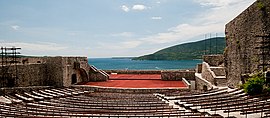Herceg Novi | |
|---|---|
Town and municipality | |
Herceg Novi | |
| Coordinates: 42°27′10.62″N 18°31′52.33″E / 42.4529500°N 18.5312028°E | |
| Country | Montenegro |
| Region | Coastal |
| Municipality | Herceg Novi |
| Founded as Sveti Stefan | 1382 |
| Settlements | 27 |
| Government | |
| • Type | Mayor-Assembly |
| • Mayor | Stevan Katić (DCG) |
| Area | |
• Town and municipality | 235 km2 (91 sq mi) |
| Population (2011 census)[1] | |
| • Rank | 3rd in Montenegro |
| • Density | 140/km2 (400/sq mi) |
| • Urban | 19,536 |
| • Rural | 11,328 |
| • Municipality | 30,864 |
| Time zone | UTC+1 (CET) |
| • Summer (DST) | UTC+2 (CEST) |
| Postal code | 85340 |
| Area code | +382 31 |
| ISO 3166-2 code | ME-08 |
| Car plates | HN |
| Website | www |
Herceg Novi (Montenegrin Cyrillic: Херцег Нови, pronounced [xěrtseɡ nôviː]) is a town in Coastal region of Montenegro located at the Western entrance to the Bay of Kotor and at the foot of Mount Orjen. It is the administrative center of the Herceg Novi Municipality with around 33,000 inhabitants. The town was founded as a fortress in 1382 by the King of Bosnia, Tvrtko I Kotromanić, and named after Saint Stephen but the name did not stick, instead it became known as Novi (transl. New), also Castelnuovo in Italian (transl. New Castle). Between 1482 and 1687 it was part of the Ottoman Empire and then from 1687 to 1797 the Albania Veneta of the Republic of Venice. It was a Catholic bishopric and remains a Latin titular see as Novi. Herceg Novi has had a turbulent past, despite being one of the youngest settlements on the Adriatic. A history of varied occupations has created a blend of diverse and picturesque architectural styles in the city.
- ^ "Results of the 2011 Census of Herceg-Novi". Herceg Novi municipality. Archived from the original on 15 August 2020. Retrieved 31 July 2017.









